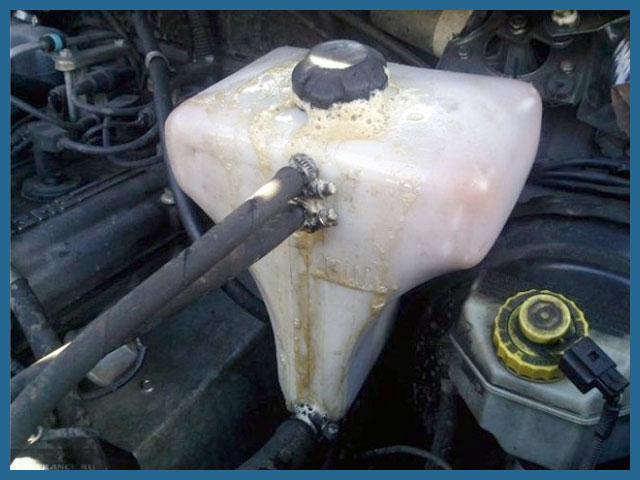
The reasons for the boiling of antifreeze in the expansion tank
Content
Normal operation of an internal combustion engine is possible only if it is continuously cooled. It occurs due to the forced circulation of antifreeze through the channels in the engine housing. However, it is not uncommon for the temperature of the coolant to rise to the boiling point. Ignoring this situation can lead to dire consequences and costly repairs. Therefore, every car owner must clearly know the procedure for boiling antifreeze.
Content
- 1 Why does antifreeze boil
- 1.1 Low level of antifreeze in the tank
- 1.2 Thermostat malfunction
- 1.2.1 Video: thermostat malfunctions
- 1.3 Radiator problems
- 1.4 Poor quality antifreeze
- 1.5 Foaming antifreeze
- 2 The consequences of boiling antifreeze
Why does antifreeze boil
There are many reasons for the boiling of the coolant (coolant) in the expansion tank, the main of which are:
- low level of antifreeze in the tank;
- malfunction of the thermostat;
- clogged radiator;
- breakdown of the cooling fan;
- poor quality of coolant.
In all these cases, the coolant does not have time to cool down. Its temperature gradually increases and when it reaches 120оStarts boiling.
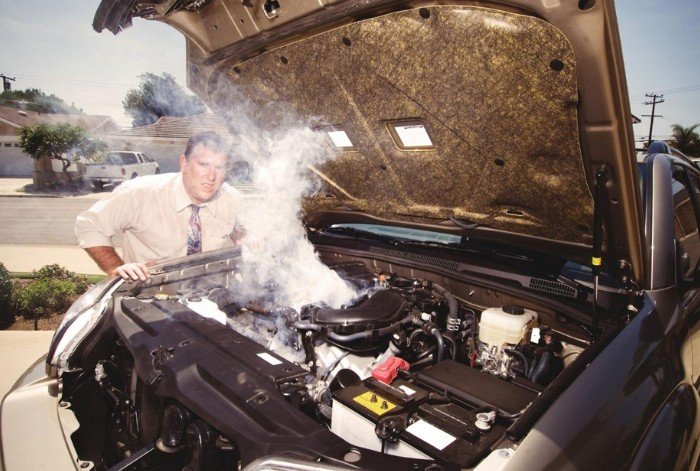
Boiling of antifreeze in the expansion tank is accompanied by white steam
Antifreeze is based on ethylene glycol - a chemical compound from the group of alcohols. It prevents the coolant from freezing in the cold. When it boils, ethylene glycol begins to evaporate. Its vapors are toxic and dangerous to the human nervous system.
Low level of antifreeze in the tank
When boiling, first of all, check the level of antifreeze in the tank. This should be done only after the coolant has completely cooled down. If a lack of fluid is detected, the following steps should be taken, depending on the situation.
- If the coolant has not been poured for a long time, you just need to add antifreeze to the required level and continue driving.

If there is little antifreeze in the expansion tank, it should be topped up.
- If the coolant has been poured recently, and its level in the tank has already dropped to a critically low level, you first need to check the integrity of the expansion tank. Then inspect all pipes, hoses and clamp connections for antifreeze leaks. If the leak is found, but it is impossible to solve the problem, you need to get to the car service on a tow truck.
Thermostat malfunction
The thermostat is a temperature regulator for the antifreeze in the engine cooling system. It accelerates engine warm-up and maintains the required thermal mode of operation.
The coolant circulates in the cooling system along a large or small circuit. When the thermostat breaks, its valve gets stuck in one position (usually up). In this case, the large circuit does not work. All antifreeze goes only in a small circle and does not have time to completely cool down.
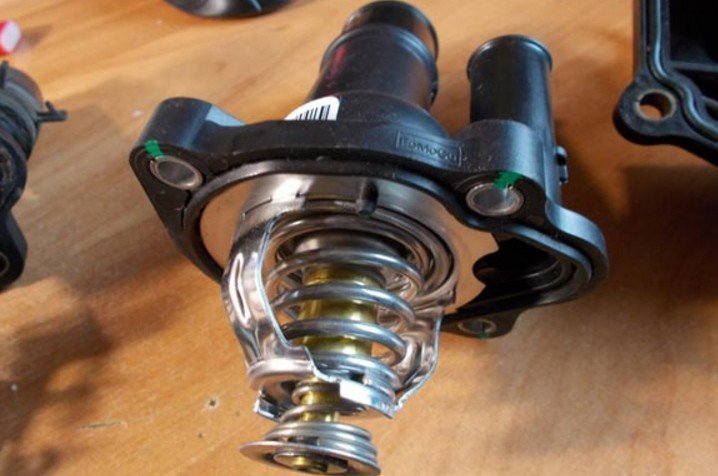
If the thermostat breaks down, only one cooling circle is activated
It is possible to determine that the thermostat is faulty as follows.
- Stop the engine and open the hood of the car.
- Locate the thermostat pipes and touch them carefully so as not to burn yourself.
- If the pipe connected to the main radiator is hotter than the others, then the thermostat is faulty.
If the thermostat breaks down within the city, you need to drive to the nearest car service and replace it. Otherwise, you should carefully continue driving, periodically (every 5–6 km) topping up the expansion tank with water. Pour water into the tank only when the engine is cold. In this way, you can get to the nearest car service and replace the thermostat.
Video: thermostat malfunctions
Radiator problems
The radiator stops working normally in three cases.
- Over time, a layer of scale appears on the radiator tubes and their thermal conductivity decreases. Gradually, the number of clogged pipes increases (when using low-quality antifreeze, this happens especially quickly), and the cooling capacity of the radiator decreases.
- Dirt gets into the radiator and the pipes become clogged. Coolant circulation in this case slows down noticeably (or stops altogether). The antifreeze temperature rises and it boils.

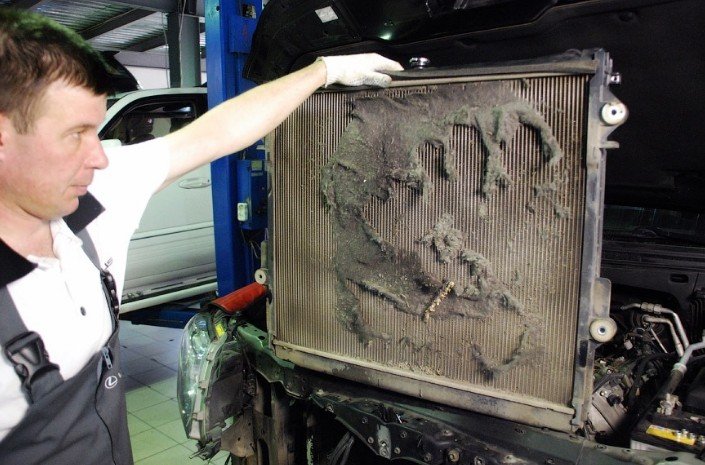
The radiator is covered with dirt and needs urgent flushing.
- When the cooling fan fails, the radiator cannot independently cool the antifreeze to the required temperature. It is possible to determine that it is the fan that is faulty by ear. If it does not turn on, the engine will run unusually quietly.
In all these cases, you can continue driving with regular stops every 7-8 kilometers.
Poor quality antifreeze
When using low quality coolant, the pump will be the first to suffer. It will begin to rust, resinous deposits will appear. Due to strong cavitation, it can even collapse.


Cavitation when using low-quality antifreeze destroys the pump
As a result, the pump impeller will rotate more slowly or stop completely. Antifreeze will stop circulating through the cooling channels of the engine and will quickly heat up and boil. Boiling will also be observed in the expansion tank.
Moreover, the pump impeller can simply dissolve in low-quality antifreeze. There are cases when the coolant turned out to be so aggressive that it caused powerful chemical corrosion of the internal parts of the pump and destroyed them in a few days. Under these circumstances, the pump shaft continues to rotate with virtually no impeller. The pressure in the cooling system drops, the antifreeze stops circulating and boils.
Operating a car with a faulty pump is almost always leads to irreversible damage to the engine. Therefore, if the pump breaks down, you should take the car in tow or call a tow truck.
Foaming antifreeze
The coolant in the expansion tank can not only boil, but also foam without increasing the temperature. Antifreeze remains cold, but a white foam cap appears on its surface.
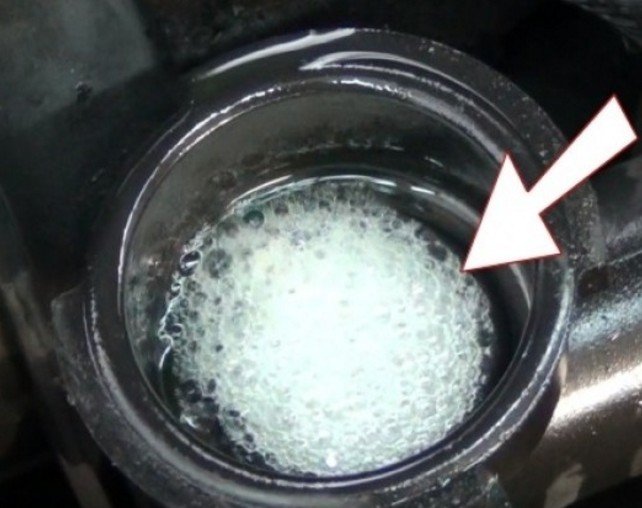

Antifreeze in the expansion tank foams when air enters the system
The main reasons for foaming are as follows.
- Poor quality antifreeze.
- Mixing two different brands of coolant - when replacing, new antifreeze was poured into the remains of the old one.
- Use of antifreeze not recommended by the car manufacturer. The chemical properties of the coolant from different manufacturers can vary significantly. Therefore, when replacing antifreeze, you should familiarize yourself with its properties, regulated in the car's manual.
- Damage to the cylinder block gasket. When the gasket is worn, air begins to flow into the cylinder block. The resulting tiny air bubbles enter the cooling system and form foam, which is visible in the expansion tank.
In the first three cases, it is enough to drain the old antifreeze from the system, flush it and fill with new coolant in accordance with the manufacturers' recommendations.
In the latter case, the damaged gasket will have to be replaced. In order to determine that it is the gasket that is damaged, you need to carefully inspect the cylinder head. If traces of oil are visible on it, then the gasket is worn out.
The consequences of boiling antifreeze
When antifreeze boils, the engine overheats. Experts distinguish between three levels of overheating: low, medium and high.
Slight overheating is observed when the engine runs with boiled antifreeze for no more than five minutes. Significant damage during this time, most likely, will not occur.
For medium overheating, the engine should run with boiling antifreeze for 10-15 minutes. Wherein:
- leaks appear in the main radiator;
- the hoses of the cooling system burst, and hot antifreeze begins to leak;
- piston rings are subject to significant shrinkage, as a result of which oil consumption can double;
- the tightness of the oil seals is broken and oil leaks.
If overheated, the engine may simply explode. Even if this did not happen, the consequences would be catastrophic:
- the pistons in the engine melt and burn out;
- cylinder heads are deformed;
- the partitions between the piston rings are completely destroyed, and the rings are welded to each other;
- valve seats crack and collapse;
- valves are deformed;
- the cylinder block gasket is partially or completely burned out.
Thus, the likelihood of antifreeze boiling in the expansion tank depends on many factors. Some factors can be easily eliminated, others require specialist intervention. In any case, overheating of the motor should be avoided. The sooner the driver notices the antifreeze boiling, the easier it will be to deal with its consequences.
